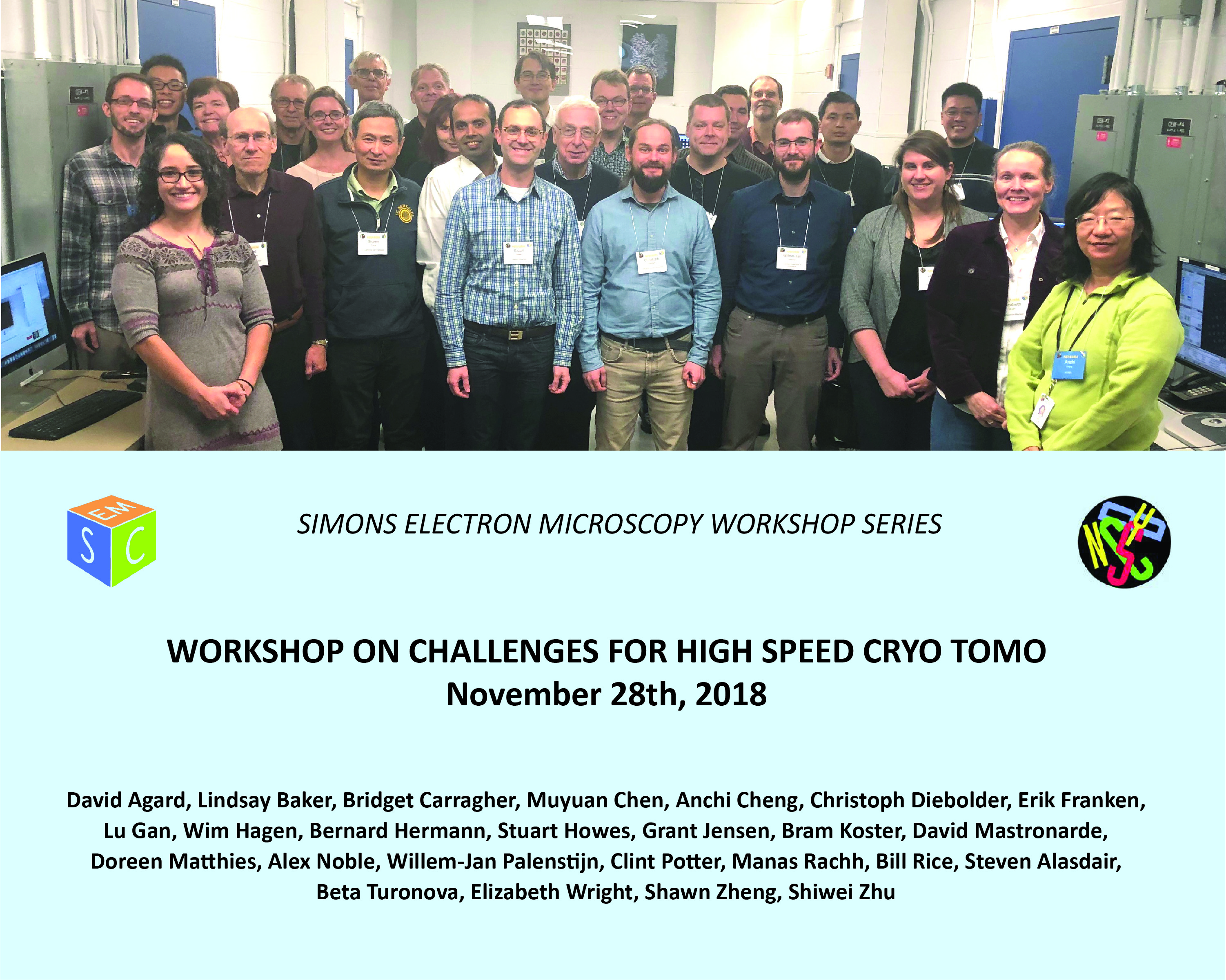11/28/2018-11/29/2018: “A Workshop on Challenges for High Speed Cryo Electron Tomography”
Cryo electron tomography (cryoET) is an enabling technique for structural studies of molecular machines either in vitro or in situ. During the last five years the performance in terms of resolution and applicability cryoET has been enormous due to the game changing technologies that transformed the application of cryoEM in general. The emergence of highly sensitive and faster detectors with electron counting capability, improved properties for prolonged and automated cryoEM data collection sessions, and optimized software and hardware for single particle analysis has resulted in mature and reasonably high throughput workflows for cryoEM. In contrast to the cryoEM workflow, existing cryoET workflows are low throughput.
The purpose of the workshop was to discuss the challenges and opportunities for high speed cryoET. We focused on understanding current workflows for cryoET, identifying the most critical bottlenecks related to quality and throughput, and proposing future work to address these bottlenecks. Aspects discussed included: (i) Goniometers: eccentricity, stability, speed, repeatability, continuous tilting; (ii) Automation; (iii) Cameras: delivery and recovery speed, acquisition modes; (iii) Novel strategies: dose rate, step size; phase plates; (iv) Image formation of highly tilted specimens; (v) Preprocessing; (vi) Need for dedicated hardware and software.
We thank Thermo Fisher Scientific for their support of this workshop.

The Agenda is below. The workshop was webcast to YouTube and the content of the first day is available here and the second day here. PDF versions of slides that have been made available by the speakers can be found by following the links attached to the speakers’s names in the agenda below.
Agenda:
Wednesday, November 28
8:30 am Welcome and Introductions
9:00 am Setting up the goals of the workshop. Bram Koster
[A description of the overall scope, vision and what we would like to achieve during the workshop. 20 minutes]
9:20 am Cryo-electron tomography. Grant Jensen
[An overview to describe the big picture for cryoET; where are we now; what works? Why does this need be improved? Identify the most critical bottlenecks related to quality and throughput. Vision for the future? 35 minutes]
[20 minutes for discussion following both talks]
10:15 am Best practices. Elizabeth Wright
[Best practices for CLEM and how to maximize productivity and consistency of results. 10 minutes + 5 minutes for discussion]
10:30 am Current practices, better options. Beata Turonova
[Optimizing the current practices and possible approaches for more robust, time-efficient
and automated pipelines. 10 minutes + 5 minutes for discussion]
10:45 am Coffee break
11:15 pm Challenges ahead. David Mastronarde
[What will be the challenges in achieving this vision? What is the low hanging fruit vs. the really difficult problems? What should we tackle vs. put to one side? 35 minutes + 10 minutes for discussion]
12:00 pm The need for speed. Lu Gan
[How nearly automated near-real-time reconstructions would make our lives a lot easier (and more productive!) 10 minutes + 5 minutes for discussion]
12:15 pm The need for speed at a big facility. Christoph Diebolder
[How preliminary real-time automatic, fiducialless reconstructions, within a couple of minutes of ending a tilt series, would save lots of beam time. 10 minutes + 5 minutes for discussion]
12:30 pm Lunch
1:15 pm Image processing challenges for continuous tilt tomography. Erik Franken
[A discussion of the European Mummering project and related efforts. 20 minutes + 10 minutes for discussion]
2:15 pm Hardware. What are we missing? What are we likely to get soon? Wim Hagen
[What will be the hardware challenges in achieving this vision? Goniometers? Cameras? Can current phase plates be part of a high throughput vision? Are there new hardware solutions under development that will help in the future? 20 minutes + 10 minutes for discussion]
2:45 pm Improving robustness and reproducibility of cryoET. Lindsay Baker
[How can we improve the effectiveness of cryoET workflows for heterogeneous and cellular samples? Can we use more and better data to help us identify weak points in our hardware and processes? 10 minutes + 5 minutes for discussion]
3:00 pm Using high-throughput cryo-ET to visualize bacterial flagellar motor. Shiwei Zhu
[10 minutes + 5 minutes for discussion]
3:15 pm Single and dual-axis phase plate tomography. Stuart Howes
[10 minutes + 5 minutes for discussion]
3:30 pm Coffee break
4:30 pm Panel Discussion. David Agard
[We encourage participants to submit questions for the panel discussion. Index cards will be readily available to write these questions down during the day, please then hand these to Clint, Bridget, Bram, or David prior to the panel discussion]
Thursday, November 29
9:00 am Real-time processing for high throughput cryoET? Willem-Jan Palenstijn
[Given the vision of high throughput cryoET, is real-time processing possible? What will be required in terms of hardware and software ? 35 minutes + 10 minutes for discussion]
9:45 am Pipeline for CryoET data processing. Muyuan Chen
[What is the status of the current pipeline for cryoET? What are desires and next steps? 10 minutes + 5 minutes for discussion]
10:00 am Fast algorithms for single-protein detection in cryo-EM tomograms. Manas Rachh
[What is the status of particle selection in tomograms? What are desires and next steps? 10 minutes + 5 minutes for discussion]
10:15 am Coffee break
11:00 am Next steps to achieving the vision. Bram Koster
[A summary of the talks and panel that brings everything into focus and puts us on a path to achieving this vision. We also hope to turn this into a white paper that will be published. 45 minutes + 15 minutes for discussion]
12:00 pm Lunch
1:00 pm End


